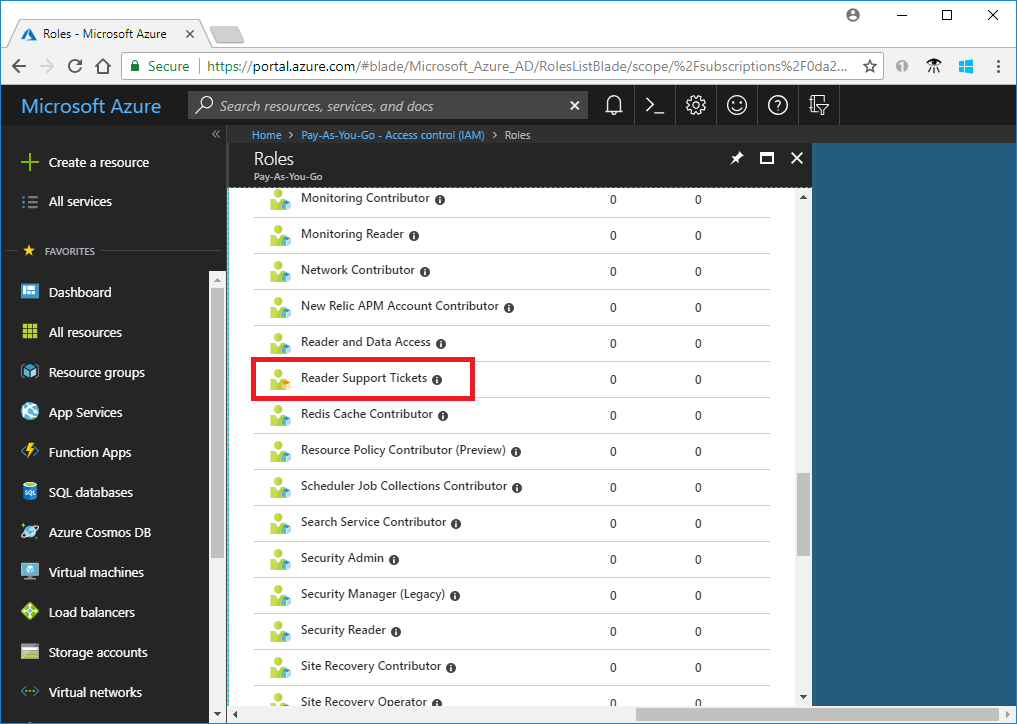If the built-in roles for Azure resources don't meet the specific needs of your organization, you can create your own custom roles. For this tutorial, you create a custom role named Reader Support Tickets using Azure CLI. The custom role allows the user to view everything in the management plane of a subscription and also open support tickets.
In this tutorial, you learn how to:
- Create a custom role
- List custom roles
- Update a custom role
- Delete a custom role
If you don't have an Azure subscription, create a free account before you begin.
Prerequisites
To complete this tutorial, you will need:
- Permissions to create custom roles, such as Owner or User Access Administrator
- Azure Cloud Shell or Azure CLI
Sign in to Azure CLI
Sign in to Azure CLI.
Create a custom role
The easiest way to create a custom role is to start with a JSON template, add your changes, and then create a new role.
- Review the list of operations for the Microsoft.Support resource provider. It's helpful to know the operations that are available to create your permissions.
- Create a new file named ReaderSupportRole.json.
- Open ReaderSupportRole.json in an editor and add the following JSON.For information about the different properties, see Custom roles for Azure resources.JSON
{ "Name": "", "IsCustom": true, "Description": "", "Actions": [], "NotActions": [], "DataActions": [], "NotDataActions": [], "AssignableScopes": [ "/subscriptions/{subscriptionId1}" ] } - Add the following operations to the
Actionsproperty. These actions allow the user to view everything in the subscription and create support tickets."*/read", "Microsoft.Support/*" - Get the ID of your subscription using the az account list command.Azure CLI
az account list --output table - In
AssignableScopes, replace{subscriptionId1}with your subscription ID.You must add explicit subscription IDs, otherwise you won't be allowed to import the role into your subscription. - Change the
NameandDescriptionproperties to "Reader Support Tickets" and "View everything in the subscription and also open support tickets."Your JSON file should look like the following:JSON{ "Name": "Reader Support Tickets", "IsCustom": true, "Description": "View everything in the subscription and also open support tickets.", "Actions": [ "*/read", "Microsoft.Support/*" ], "NotActions": [], "DataActions": [], "NotDataActions": [], "AssignableScopes": [ "/subscriptions/00000000-0000-0000-0000-000000000000" ] } - To create the new custom role, use the az role definition create command and specify the JSON role definition file.Azure CLI
az role definition create --role-definition "~/CustomRoles/ReaderSupportRole.json"Output{ "additionalProperties": {}, "assignableScopes": [ "/subscriptions/00000000-0000-0000-0000-000000000000" ], "description": "View everything in the subscription and also open support tickets.", "id": "/subscriptions/00000000-0000-0000-0000-000000000000/providers/Microsoft.Authorization/roleDefinitions/22222222-2222-2222-2222-222222222222", "name": "22222222-2222-2222-2222-222222222222", "permissions": [ { "actions": [ "*/read", "Microsoft.Support/*" ], "additionalProperties": {}, "dataActions": [], "notActions": [], "notDataActions": [] } ], "roleName": "Reader Support Tickets", "roleType": "CustomRole", "type": "Microsoft.Authorization/roleDefinitions" }The new custom role is now available and can be assigned to users, groups, or service principals just like built-in roles.
List custom roles
- To list all your custom roles, use the az role definition list command with the
--custom-role-onlyparameter.Azure CLIaz role definition list --custom-role-only trueOutput[ { "additionalProperties": {}, "assignableScopes": [ "/subscriptions/00000000-0000-0000-0000-000000000000" ], "description": "View everything in the subscription and also open support tickets.", "id": "/subscriptions/00000000-0000-0000-0000-000000000000/providers/Microsoft.Authorization/roleDefinitions/22222222-2222-2222-2222-222222222222", "name": "22222222-2222-2222-2222-222222222222", "permissions": [ { "actions": [ "*/read", "Microsoft.Support/*", "Microsoft.Resources/deployments/*", "Microsoft.Insights/diagnosticSettings/*/read" ], "additionalProperties": {}, "dataActions": [], "notActions": [], "notDataActions": [] } ], "roleName": "Reader Support Tickets", "roleType": "CustomRole", "type": "Microsoft.Authorization/roleDefinitions" } ]You can also see the custom role in the Azure portal.
Update a custom role
To update the custom role, update the JSON file and then update the custom role.
- Open the ReaderSupportRole.json file.
- In
Actions, add the operation to create and manage resource group deployments"Microsoft.Resources/deployments/*". Be sure to include a comma after the previous operation.Your updated JSON file should look like the following:JSON{ "Name": "Reader Support Tickets", "IsCustom": true, "Description": "View everything in the subscription and also open support tickets.", "Actions": [ "*/read", "Microsoft.Support/*", "Microsoft.Resources/deployments/*" ], "NotActions": [], "DataActions": [], "NotDataActions": [], "AssignableScopes": [ "/subscriptions/00000000-0000-0000-0000-000000000000" ] } - To update the custom role, use the az role definition update command and specify the updated JSON file.Azure CLI
az role definition update --role-definition "~/CustomRoles/ReaderSupportRole.json"Output{ "additionalProperties": {}, "assignableScopes": [ "/subscriptions/00000000-0000-0000-0000-000000000000" ], "description": "View everything in the subscription and also open support tickets.", "id": "/subscriptions/00000000-0000-0000-0000-000000000000/providers/Microsoft.Authorization/roleDefinitions/22222222-2222-2222-2222-222222222222", "name": "22222222-2222-2222-2222-222222222222", "permissions": [ { "actions": [ "*/read", "Microsoft.Support/*", "Microsoft.Resources/deployments/*" ], "additionalProperties": {}, "dataActions": [], "notActions": [], "notDataActions": [] } ], "roleName": "Reader Support Tickets", "roleType": "CustomRole", "type": "Microsoft.Authorization/roleDefinitions" }
Delete a custom role
- Use the az role definition delete command and specify the role name or role ID to delete the custom role.Azure CLI
az role definition delete --name "Reader Support Tickets"

No comments:
Post a Comment